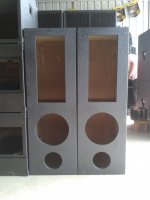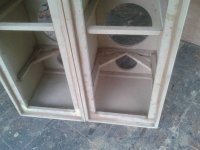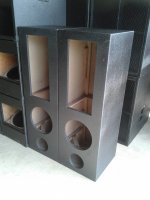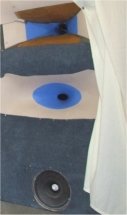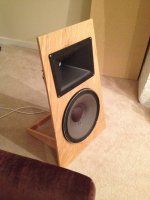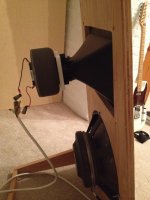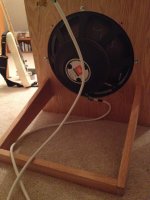Hugh2000,
If they will allow discussion in this forum, I would like to ask, if you have heard other Speakers with Side-Firing Low-Bass drivers?
I've only heard a couple, both with high reputations for commercially made speakers (Canton, Definitive Technology), and I noticed something of a disconnect between the front speakers and the side Low-Bass driver. Neither speakers sounded bad, if fact I came very very close to buying the Canton Karat. I thought they would have made great movie speakers.
But, the Low-Bass very much sounded like it was coming from a different source, as if there were two speakers playing. The integration, from the perspective of sound, did not seem as tight and smooth as a speaker with all front firing drivers.
But, upon viewing your images, I notice your Side-Firing Low-Bass are up very high up, very near the Front-Firing Mid-Bass/Tweeter. Most commercial designs have the Side Low-Bass down very low.
Was that intentional on your part, and do you feel this higher placed Low-Bass design helps the Side-Firing better integrate with the Front-Firing Mid-Bass/Tweeter?
Just curious.
Steve/bluewizard
If they will allow discussion in this forum, I would like to ask, if you have heard other Speakers with Side-Firing Low-Bass drivers?
I've only heard a couple, both with high reputations for commercially made speakers (Canton, Definitive Technology), and I noticed something of a disconnect between the front speakers and the side Low-Bass driver. Neither speakers sounded bad, if fact I came very very close to buying the Canton Karat. I thought they would have made great movie speakers.
But, the Low-Bass very much sounded like it was coming from a different source, as if there were two speakers playing. The integration, from the perspective of sound, did not seem as tight and smooth as a speaker with all front firing drivers.
But, upon viewing your images, I notice your Side-Firing Low-Bass are up very high up, very near the Front-Firing Mid-Bass/Tweeter. Most commercial designs have the Side Low-Bass down very low.
Was that intentional on your part, and do you feel this higher placed Low-Bass design helps the Side-Firing better integrate with the Front-Firing Mid-Bass/Tweeter?
Just curious.
Steve/bluewizard
I've heard so far just a few low end speakers with just one side firing bass driver that sounded bad anyways, so i cannot make a comparison, maybe high end ones sound better.
I was inspired by the Kef Blade approach regarding driver placement and yes, i feel too a difference between them and a speaker with all drivers front firing.At the beginning a huge one, but after some crossover modifications not that much.In fact, from the people who listened them so far, all said the speakers sound ok.
I do feel that the position of the bass drivers helps, and maybe a smaller crossover point would have helped too.
I was inspired by the Kef Blade approach regarding driver placement and yes, i feel too a difference between them and a speaker with all drivers front firing.At the beginning a huge one, but after some crossover modifications not that much.In fact, from the people who listened them so far, all said the speakers sound ok.
I do feel that the position of the bass drivers helps, and maybe a smaller crossover point would have helped too.
Wave guide TMM
My wave guide TMM is an active system with an electrical 4th order cross at 1700hz. It uses a Dave Pellegrene wave guide on an XT25-60 and two Dayton RS180's. The XT25 with a cap is flat to there. The lower RS180 has a 4.0 coil on it for an early roll out at 275hz. This gave me the flattest in room response before EQ. The 3000hz freq that activates the twin peaks is down 20db on the upper RS180.
The lift from the WG is countered with a 4.7 cap which lowers the bottom end distortion and resonance at 600hz. With the DCX2496, I have a notch at both the twin peaks of the Rs180 and at the tweeter's 600hz res. This is a very clean sounding set-up with 10db added to the tweeter's ultimate SPL capabilty which is already quite robust.
Its output is unreal and the systems ultimate outpt SPL is limited by the TC sounds' 15's (4 of them) amp power. I run 2 Peavey 4080hz amps bridged for 8000 watts total.
Its clean and loud.
The cabinets are finished in duratex so I have no light reflections from my front projection home theater. They look profession to me but then I'm biased. The grills have driver sized cutouts with beveled edges as the openings. I hear no difference with the grills on or off.
The grills in place before paint and cloth applied to show the cutouts/bevel
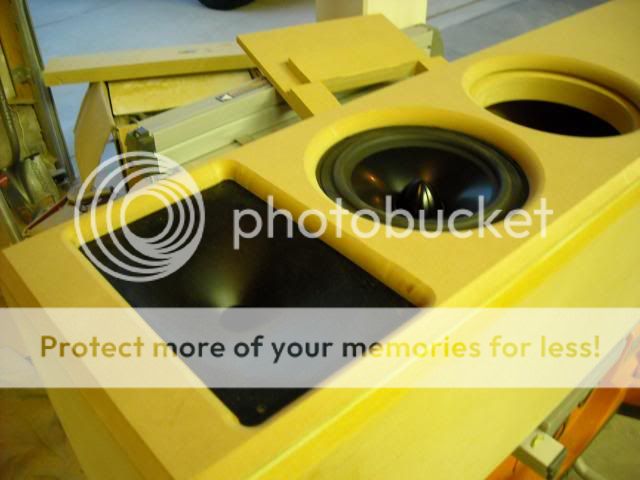
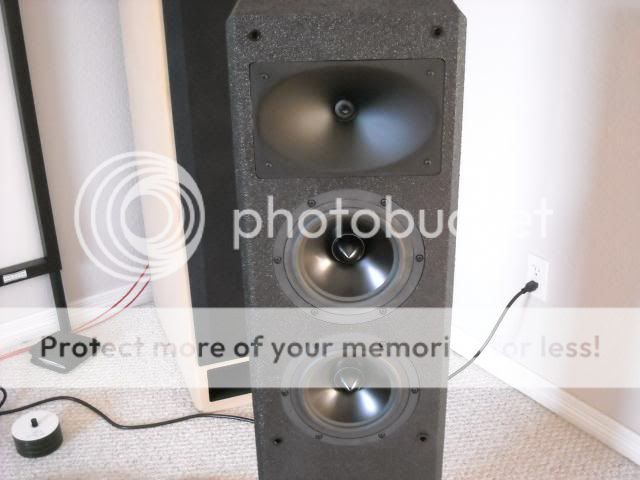
A spacer under the speaker makes it look like its floating over the granite base.
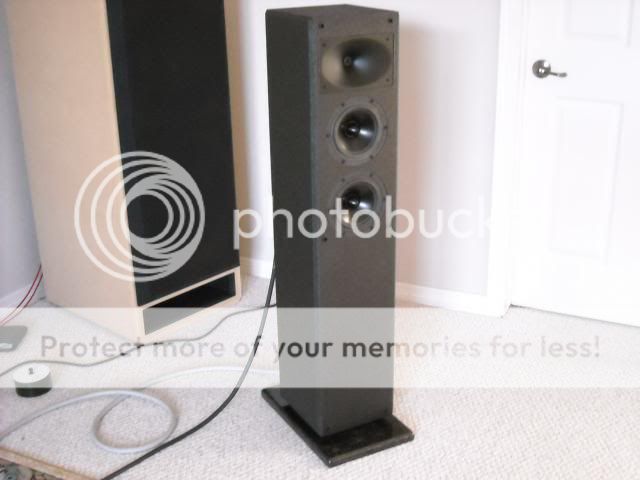
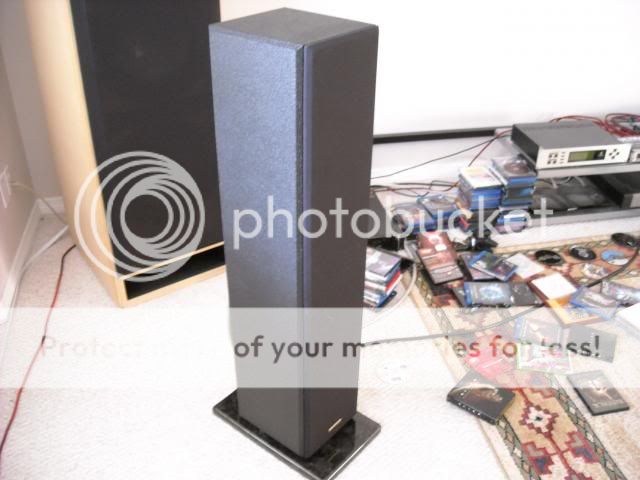
Granite bases were $75 each
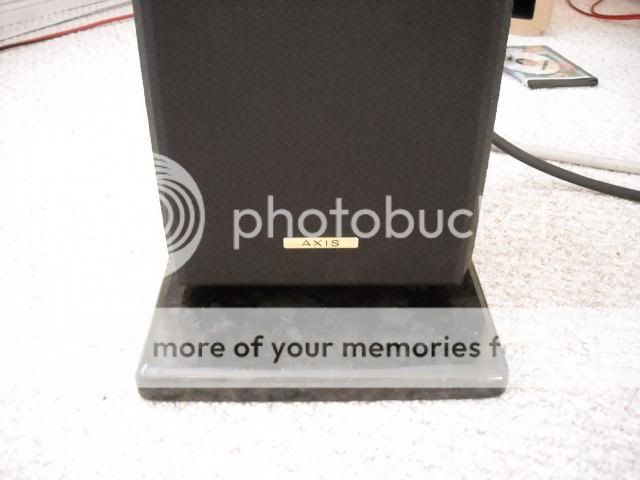
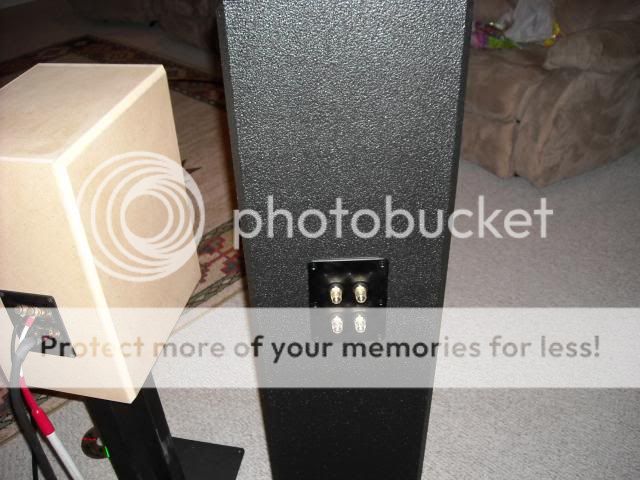
16 foot diag screen. I couldnt have glossy speakers due to reflections.
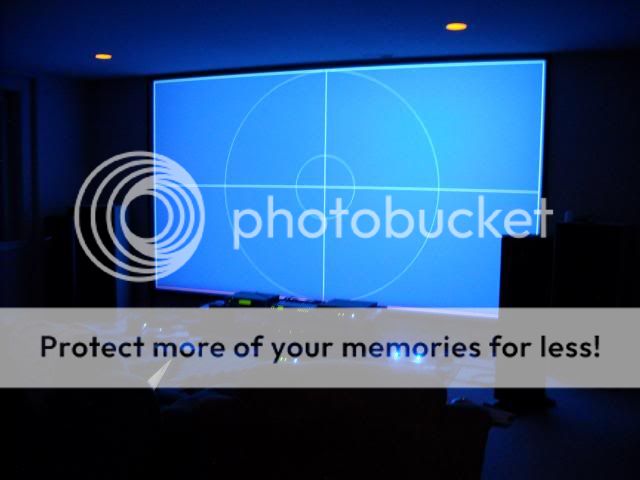
My wave guide TMM is an active system with an electrical 4th order cross at 1700hz. It uses a Dave Pellegrene wave guide on an XT25-60 and two Dayton RS180's. The XT25 with a cap is flat to there. The lower RS180 has a 4.0 coil on it for an early roll out at 275hz. This gave me the flattest in room response before EQ. The 3000hz freq that activates the twin peaks is down 20db on the upper RS180.
The lift from the WG is countered with a 4.7 cap which lowers the bottom end distortion and resonance at 600hz. With the DCX2496, I have a notch at both the twin peaks of the Rs180 and at the tweeter's 600hz res. This is a very clean sounding set-up with 10db added to the tweeter's ultimate SPL capabilty which is already quite robust.
Its output is unreal and the systems ultimate outpt SPL is limited by the TC sounds' 15's (4 of them) amp power. I run 2 Peavey 4080hz amps bridged for 8000 watts total.
Its clean and loud.
The cabinets are finished in duratex so I have no light reflections from my front projection home theater. They look profession to me but then I'm biased. The grills have driver sized cutouts with beveled edges as the openings. I hear no difference with the grills on or off.
The grills in place before paint and cloth applied to show the cutouts/bevel


A spacer under the speaker makes it look like its floating over the granite base.


Granite bases were $75 each


16 foot diag screen. I couldnt have glossy speakers due to reflections.

Last edited:
Hugh2000,
If they will allow discussion in this forum, I would like to ask, if you have heard other Speakers with Side-Firing Low-Bass drivers?
I've only heard a couple, both with high reputations for commercially made speakers (Canton, Definitive Technology), and I noticed something of a disconnect between the front speakers and the side Low-Bass driver. Neither speakers sounded bad, if fact I came very very close to buying the Canton Karat. I thought they would have made great movie speakers.
But, the Low-Bass very much sounded like it was coming from a different source, as if there were two speakers playing. The integration, from the perspective of sound, did not seem as tight and smooth as a speaker with all front firing drivers.
But, upon viewing your images, I notice your Side-Firing Low-Bass are up very high up, very near the Front-Firing Mid-Bass/Tweeter. Most commercial designs have the Side Low-Bass down very low.
Was that intentional on your part, and do you feel this higher placed Low-Bass design helps the Side-Firing better integrate with the Front-Firing Mid-Bass/Tweeter?
Just curious.
Steve/bluewizard
The issue with adding any driver to a system in that fashion has quite a bit of its success dependent upon time alignment/phase. Subwoofers that are in separate enclosures at varying distances from the main speakers usually have a means to adjust this variable. If you build speakers as a DIY project, its difficult to do in a passive crossover and requires a lot of skill. Active speakers are much easier to achieve this integration with. A crossover such as a Behringer DCX2496 can do this adjustment for you.
My system pictured above, has 4 15" subs located behind the mains by about 4 feet. Before I adjusted for the distance and phase, it was poorly integrated. Now it sounds like a single system.
This new speaker company totally copied the look of Avalon speakers.
Black Moon Audio Fidelity One Loudspeaker
Black Moon Audio Fidelity One Loudspeaker
Altec BR in Thailand
Re-incarnating a design I came up with when in Hawaii. Not going for perfection, just a pleasing compromise (WAF?). I will add cross bracing on the middle brace in 2 directions. Having a local shop (no English) build them. I pick up this Saturday.
160 L. 150x300 mm port. Altec 808-8a/811 over 419b re-coned with 414b.
Minidsp/miniamp stack in each putting 20w continuous into each driver.
Looking to cross at 500Hz. Source, headphone jack out of my PC.
I realize that they would probably work better on a shelf, laying down. The original idea was to get everything in one box and minimize frontal area. Maybe put on a short stand?
Comments/suggestions welcome.
Re-incarnating a design I came up with when in Hawaii. Not going for perfection, just a pleasing compromise (WAF?). I will add cross bracing on the middle brace in 2 directions. Having a local shop (no English) build them. I pick up this Saturday.
160 L. 150x300 mm port. Altec 808-8a/811 over 419b re-coned with 414b.
Minidsp/miniamp stack in each putting 20w continuous into each driver.
Looking to cross at 500Hz. Source, headphone jack out of my PC.
I realize that they would probably work better on a shelf, laying down. The original idea was to get everything in one box and minimize frontal area. Maybe put on a short stand?
Comments/suggestions welcome.
Attachments
My new toys (A bit bigger than a bookshelf) 
Bass: JBL 2226H
Treble: JBL 2426H on tractrix horn (From horns.pl, 350 model)
1,2 kHz 1º order.
Bass: JBL 2226H
Treble: JBL 2426H on tractrix horn (From horns.pl, 350 model)
1,2 kHz 1º order.
An externally hosted image should be here but it was not working when we last tested it.
An externally hosted image should be here but it was not working when we last tested it.
An externally hosted image should be here but it was not working when we last tested it.
An externally hosted image should be here but it was not working when we last tested it.
An externally hosted image should be here but it was not working when we last tested it.
An externally hosted image should be here but it was not working when we last tested it.
My current experiments in OB. Oak woodwork.
Bass is 2226H, top is open-backed 2470 with Radian diaphragm. Crossover is nanoDigi at 1200Hz (for now - I've not measured these yet). Passive compensation at input of the bass amp is 1k0 series then 1u5 + 330R to ground.
Bass is 2226H, top is open-backed 2470 with Radian diaphragm. Crossover is nanoDigi at 1200Hz (for now - I've not measured these yet). Passive compensation at input of the bass amp is 1k0 series then 1u5 + 330R to ground.
Attachments
Inguz: why the compensation? One of the strengths of OBs is dipolar effect. With the horn being enclosed at the rear this will not happen. GeneraLy to produce good bass a large woofer is used e.g. 12". To help with the bass a large\wide baffle board is employed. What I have noticed with the OBs I have build is not always deep bass but very articulated bass.
Try your design with an open back midrange driver and tweeter or just a small mid\tweeter driver for that dipolar effect. Your build looks clean and neat.
Is that a Fender a Telecaster in the background. I had a blonde body one myself many years back.
Try your design with an open back midrange driver and tweeter or just a small mid\tweeter driver for that dipolar effect. Your build looks clean and neat.
Is that a Fender a Telecaster in the background. I had a blonde body one myself many years back.
Last edited:
There's a compensation network on the woofer (analog, not digital, for headroom reasons) mostly because this started with no baffle at all, where the corner frequency is ~1kHz. Still early days for experiments. Right now it's pleasantly full bass, enough to keep me very happy with stuff like James Blake and Holden, without any of the "room boom" that I've been used to. I'll take some measurements later and post a new thread.
The horn sounds great; crisp, detailed. I had a real shock when listening with the backs off; the top end became very open and airy all through the room. There's some HF dipole effect, although not much in the mids above crossover.
The beat-up old tele doesn't get enough use. It's there for inspiration
The horn sounds great; crisp, detailed. I had a real shock when listening with the backs off; the top end became very open and airy all through the room. There's some HF dipole effect, although not much in the mids above crossover.
The beat-up old tele doesn't get enough use. It's there for inspiration
A little off thread but what year is the Tele and is it a genuine USA model or Jap or Mexican?There's a compensation network on the woofer (analog, not digital, for headroom reasons) mostly because this started with no baffle at all, where the corner frequency is ~1kHz. Still early days for experiments. Right now it's pleasantly full bass, enough to keep me very happy with stuff like James Blake and Holden, without any of the "room boom" that I've been used to. I'll take some measurements later and post a new thread.
The horn sounds great; crisp, detailed. I had a real shock when listening with the backs off; the top end became very open and airy all through the room. There's some HF dipole effect, although not much in the mids above crossover.
The beat-up old tele doesn't get enough use. It's there for inspiration
- Home
- Loudspeakers
- Multi-Way
- System Pictures & Description



